 Facebook
Facebook
 X
X
 Instagram
Instagram
 TikTok
TikTok
 Youtube
Youtube

As a young adult in San Diego, Bertrand at Mister A’s was one of those fine-dining establishments in the sky (or 12th floor, to be precise) that I never felt “fancy enough” to enter. I remember, from a visit over a decade ago, how the maître d', in a friendly but firm manner, proffered a tie to my date, who’d walked in wearing a button-down shirt and jacket. Now that I’m in my thirties, I'm more comfortable with fancy, but I have also learned the difference between classy and uptight. Mister A’s may be the former, but my recent visit revealed it is far from the latter.

“We’re trying to meet the city half way, to be more ‘San Diego’ fine dining,” says Mister A’s general manager Ryan Thorsen. “At the end of the day, we had a dress code before that was so stringent, that it was completely unrealistic to not pay attention to the fact that so much of the city walks around in flip flops. Not that we want to change our image,” he clarifies, “But make it more accessible. We try to do away with all those predispositions of being stodgy.”
One way they’re doing this is by pushing the more casual outdoor dining options, particularly for brunch (just added this past year) and lunch. I'll be checking out the new brunch scene soon, but because I wanted an update on the date-night experience, I went to check out the dinner scene first. I’d called in advance to double-check that the jacket-rule had been relaxed, and was told that short-sleeves were discouraged, tank tops were right out, but a nice sweater was acceptable. David wore black pants, and a simple grey v-neck cashmere sweater over a shirt.
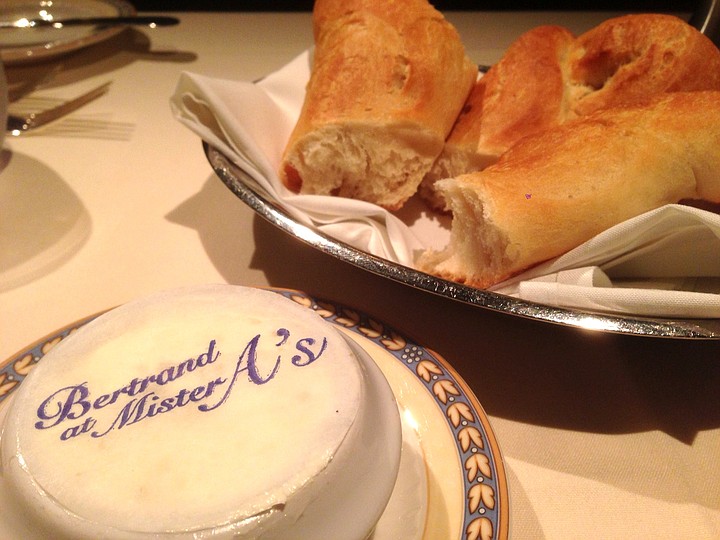
The first thing we noticed upon taking our seats were how immaculate all the glasses were. “Look,” David said, as he held one up. “Not one smudge. That’s pretty impressive.”

The bread, we were told, is bought partially baked and finished in house. It was served with fresh-tasting sweet cream butter topped with grey sea salt.
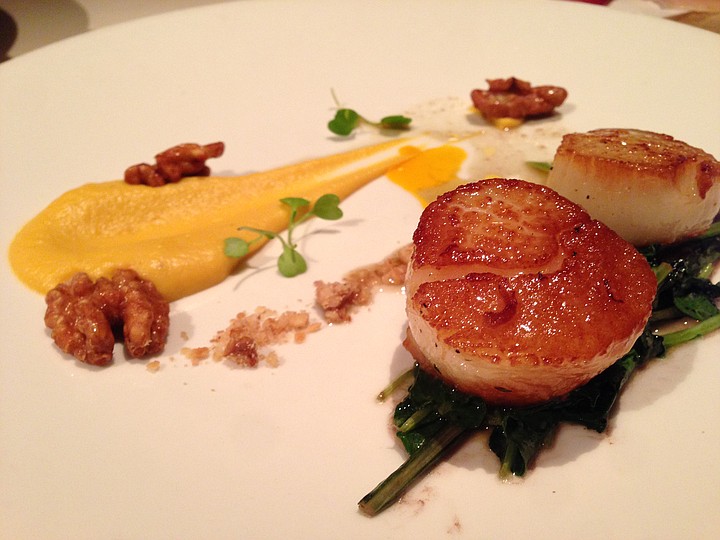
Prior to the ordered food came a comfort-foody amuse bouche, a cute little empanada that was as tasty as it was adorable. A hint of salt brought out the flavor of the fried dough.
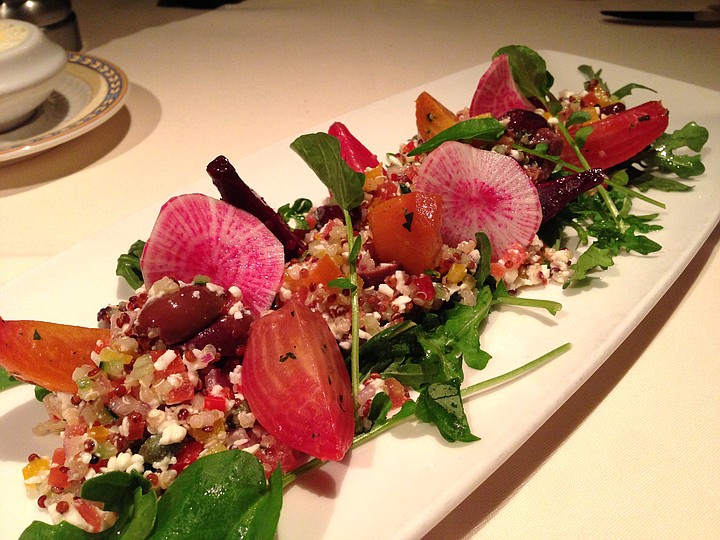
We began with seared Maine scallops, served with butternut squash puree and baby arugula in a hazelnut oil. The greens were on the salty side, but the squash puree had a fresh and natural sweetness, and when combined all together (scallop perfectly seared, salty arugula, sweet squash), the composed bite was well balanced.
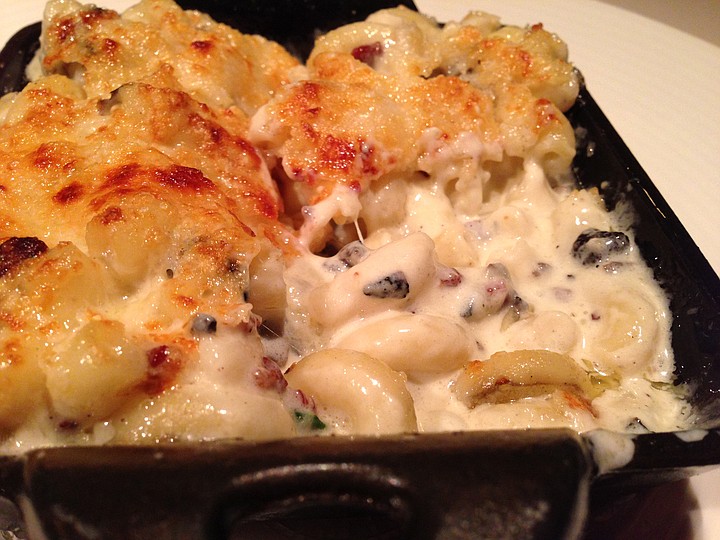
The multi-colored baby beets salad was an exciting twist on a simple classic. Typically, beet salads comprise beets, greens, a balsamic drizzle, either feta or goat cheese, and, for a more extravagant version, a spattering of candied nuts. Mister A's French-born Chef de Cuisine Stéphane Voitzwinkler's variant pushed salty and savory notes, instead of the usual sweet. Finely chopped together, but each flavor pronounced, were cucumber, kalamata olives, bell peppers, feta, capers, onion, and quinoa. It was as pleasurable to the taste buds as it was to the eyes.
A friend suggested we taste a popular side dish, the mac and cheese. The chef uses Comté cheese, a highly regulated French export that has been produced the same way since the time of Charlemagne (i.e., the late 700s). The kitchen wasn’t skimpy with the chunks of black truffles. The pancetta provided a mild insinuation of salt, but was mostly imperceptible. Overall, the character of this mac and cheese was pleasantly light (and definitely fancy) for what is often a decidedly heavy, down-home dish.
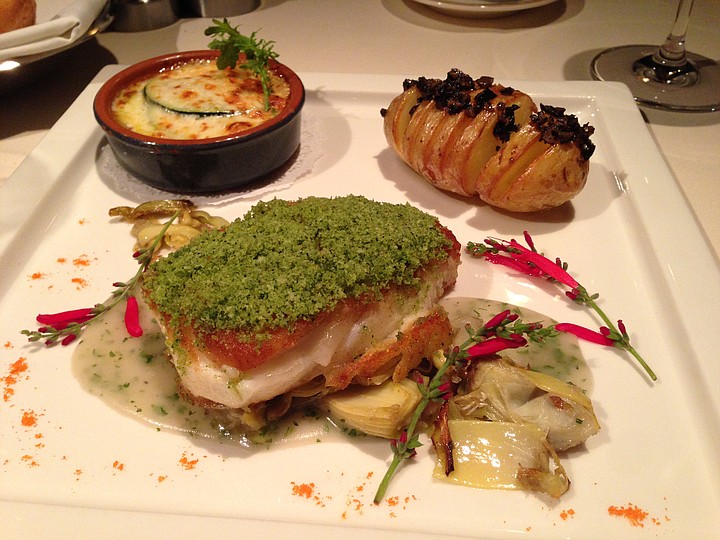
I ordered the roasted sea bass in herb crust. David didn’t care for the green herb crust on top — he said it felt more sandy than crusty. I agreed regarding the texture, but I didn’t mind it; I figured it was meant to be more of an herbed bread-crumb topping than cooked-on crust. The presentation appeared to not be integrated — a terrine of zucchini, a potato with black truffles, a ramekin of zucchini gratin. In David’s words, “The potato is just hanging out over there with the truffle.” Bass is a mild fish, making the strong flavor of truffle seem overpowering. The zucchini gratin was delicate, more milk than heavy cream, but not nearly as interesting in flavor as what was going on underneath the fish. I stuck with the best part of the plate — the fish, not overcooked and with a lovely sear, in Riesling sauce with baby artichokes.
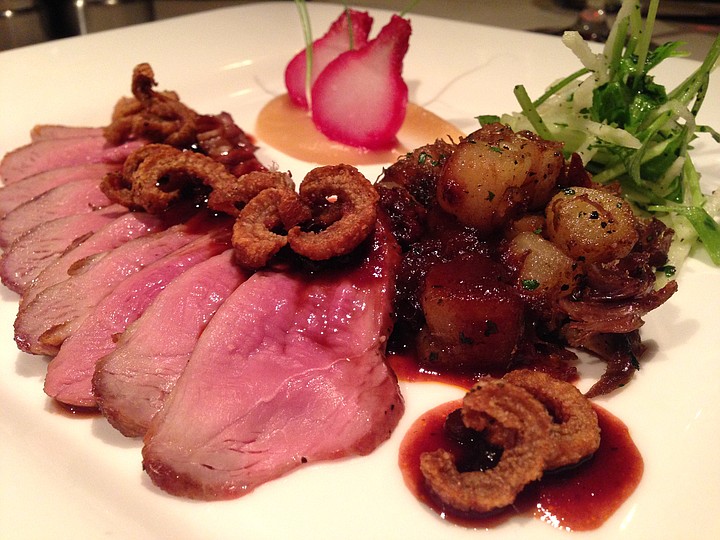
I never order duck, but I always taste it if it’s around, and I find that I like what I taste about 40 percent of the time. Even when I enjoy the sample it, it’s in a, “Hm, yeah, I can see how that works, but it’s not my personal preference,” sort of way. This duck dish was an exception. The crispy pan sautéed Moulard duck breast with huckleberry sauce and smoked potato hash, the crispy skin and apple blend — it was nothing short of lip-smacking. The duck, prepared rare, had the texture and flavor quality of a beautiful prime steak, and when mixed with the smoky hash and tangy but sweet fruit purees... let's just say the moans at our table were audible.
With dinner, we sipped a wine you can't get anywhere but at one of Bertrand's restaurants (the other being Mille Fleurs) — the "Cuvee Bertrant," a lush, full-bodied, balanced, New World-style pinot noir the owner and wine columnist developed at Tantara in Santa Barbara. At $50 on a restaurant wine list, the QPR (quality price ratio) was outstanding. We were disappointed to learn we couldn't buy it retail.
I didn't taste the lamb, but it was another beautiful plating. As with the duck, the fine meat was cooked on the rare side, and David described it as executed perfectly. As far as the accoutrements on the plate, he particularly favored the edamame in the vinaigrette, but found the fried potato bits to be bland, and the Brussels sprouts to be under-seasoned. His favorite part of the dish was the purple mustard (an exotic, spicy mustard), particularly when eaten with the lamb.
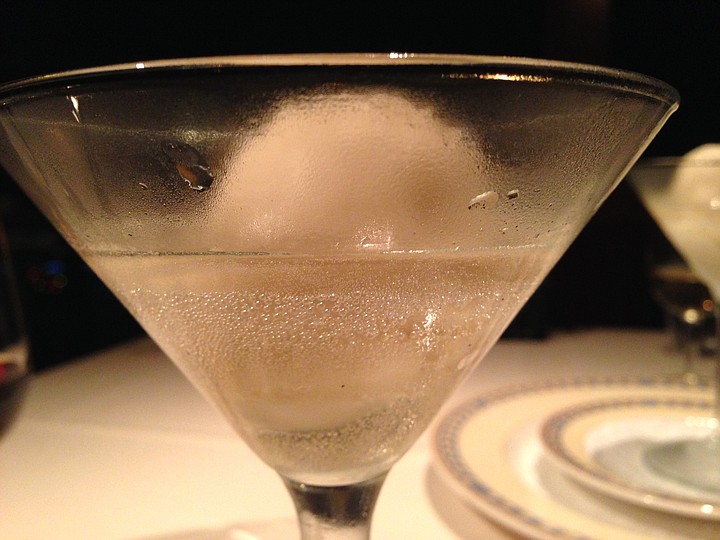
Before considering dessert, we were encouraged to check out the view. “I sometimes suggest people go outside at this point, enjoy the view and the air, maybe do a few laps,” our server joked. This encouragement sent a very clear message that made us feel even more at ease than we already were: “We are not trying to rush you out the door so we can flip your table. Make yourself comfortable, stay awhile.” It felt odd to temporarily abandon our table, but once we were outside — strolling around the patio, watching planes float by at eye-level, and breathing in one of the best views in the city — we were glad to have taken our server's suggestion seriously. While we were outside, David captured a cool long-exposure of downtown with a plane coming in.
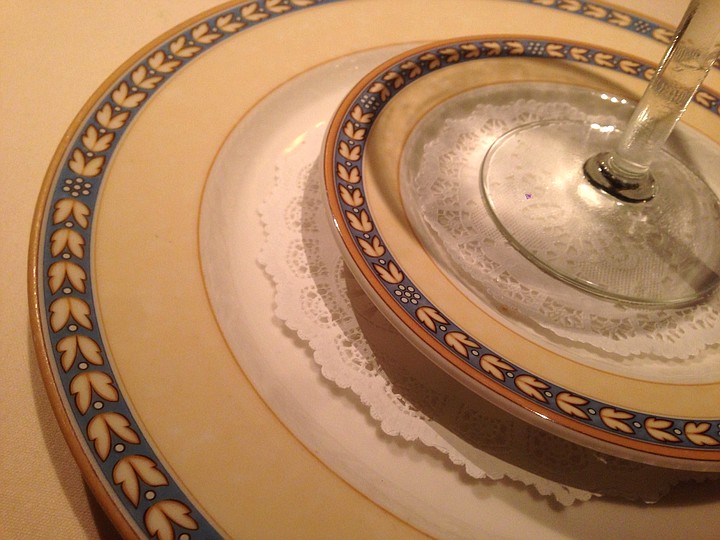
Back at our table, we received an intermezzo, a refreshing scoop of citrus sorbet in a pool of Prosecco. We couldn’t help but be conscious of Mister A’s fancy French origins when David pointed out that the martini glass had been served “on a doily on a small plate, that is on another doily, on a larger plate.”

The desserts looked amazing, but I was only up for one more bite, so I chose to taste the salted caramel ganache bar, with peanut praline crisp and brown butter popcorn ice cream. Salt, sugar, creamy, crunchy, it was everything I'd want a final bite to be. I chose wisely.
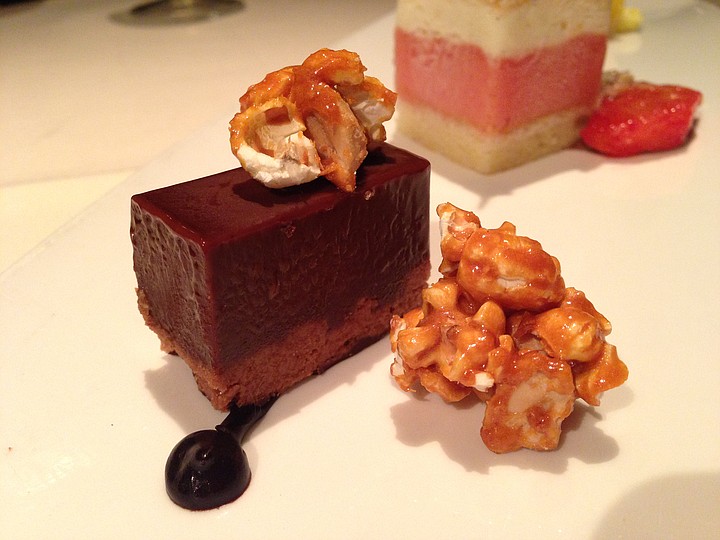
While we were finishing dessert, a man and woman were seated at a table nearby. The man — probably in his late twenties or early thirties – held a ball cap his hands. He placed it on the table as he took his seat. I grabbed the maître d and confirmed what I’d suspected — that he’d had to ask the gentleman to please remove his hat, and the guy “wasn’t happy about it.” He also told me that, on Valentine’s Day, he’d offered a jacket to a young man who’d arrived in a tank top. Rather than accepting the offer, the man, offended, chose to leave.
“The gentlemen are the biggest issue,” Thorsen shared. “The ladies all come dressed to the nines, but guys come in t-shirts and jeans.” I commented about another man I'd noticed, two tables over, who was wearing a pink short-sleeved Polo shirt with a collar. “I never would have seen that here ten years ago,” I said. Thorsen explained that as long as there is a “business casual” appropriateness to the attire, the staff doesn't intervene. “Really, though, we take it on a case-by-case basis.”


As a young adult in San Diego, Bertrand at Mister A’s was one of those fine-dining establishments in the sky (or 12th floor, to be precise) that I never felt “fancy enough” to enter. I remember, from a visit over a decade ago, how the maître d', in a friendly but firm manner, proffered a tie to my date, who’d walked in wearing a button-down shirt and jacket. Now that I’m in my thirties, I'm more comfortable with fancy, but I have also learned the difference between classy and uptight. Mister A’s may be the former, but my recent visit revealed it is far from the latter.

“We’re trying to meet the city half way, to be more ‘San Diego’ fine dining,” says Mister A’s general manager Ryan Thorsen. “At the end of the day, we had a dress code before that was so stringent, that it was completely unrealistic to not pay attention to the fact that so much of the city walks around in flip flops. Not that we want to change our image,” he clarifies, “But make it more accessible. We try to do away with all those predispositions of being stodgy.”
One way they’re doing this is by pushing the more casual outdoor dining options, particularly for brunch (just added this past year) and lunch. I'll be checking out the new brunch scene soon, but because I wanted an update on the date-night experience, I went to check out the dinner scene first. I’d called in advance to double-check that the jacket-rule had been relaxed, and was told that short-sleeves were discouraged, tank tops were right out, but a nice sweater was acceptable. David wore black pants, and a simple grey v-neck cashmere sweater over a shirt.

The first thing we noticed upon taking our seats were how immaculate all the glasses were. “Look,” David said, as he held one up. “Not one smudge. That’s pretty impressive.”

The bread, we were told, is bought partially baked and finished in house. It was served with fresh-tasting sweet cream butter topped with grey sea salt.

Prior to the ordered food came a comfort-foody amuse bouche, a cute little empanada that was as tasty as it was adorable. A hint of salt brought out the flavor of the fried dough.

We began with seared Maine scallops, served with butternut squash puree and baby arugula in a hazelnut oil. The greens were on the salty side, but the squash puree had a fresh and natural sweetness, and when combined all together (scallop perfectly seared, salty arugula, sweet squash), the composed bite was well balanced.

The multi-colored baby beets salad was an exciting twist on a simple classic. Typically, beet salads comprise beets, greens, a balsamic drizzle, either feta or goat cheese, and, for a more extravagant version, a spattering of candied nuts. Mister A's French-born Chef de Cuisine Stéphane Voitzwinkler's variant pushed salty and savory notes, instead of the usual sweet. Finely chopped together, but each flavor pronounced, were cucumber, kalamata olives, bell peppers, feta, capers, onion, and quinoa. It was as pleasurable to the taste buds as it was to the eyes.
A friend suggested we taste a popular side dish, the mac and cheese. The chef uses Comté cheese, a highly regulated French export that has been produced the same way since the time of Charlemagne (i.e., the late 700s). The kitchen wasn’t skimpy with the chunks of black truffles. The pancetta provided a mild insinuation of salt, but was mostly imperceptible. Overall, the character of this mac and cheese was pleasantly light (and definitely fancy) for what is often a decidedly heavy, down-home dish.

I ordered the roasted sea bass in herb crust. David didn’t care for the green herb crust on top — he said it felt more sandy than crusty. I agreed regarding the texture, but I didn’t mind it; I figured it was meant to be more of an herbed bread-crumb topping than cooked-on crust. The presentation appeared to not be integrated — a terrine of zucchini, a potato with black truffles, a ramekin of zucchini gratin. In David’s words, “The potato is just hanging out over there with the truffle.” Bass is a mild fish, making the strong flavor of truffle seem overpowering. The zucchini gratin was delicate, more milk than heavy cream, but not nearly as interesting in flavor as what was going on underneath the fish. I stuck with the best part of the plate — the fish, not overcooked and with a lovely sear, in Riesling sauce with baby artichokes.

I never order duck, but I always taste it if it’s around, and I find that I like what I taste about 40 percent of the time. Even when I enjoy the sample it, it’s in a, “Hm, yeah, I can see how that works, but it’s not my personal preference,” sort of way. This duck dish was an exception. The crispy pan sautéed Moulard duck breast with huckleberry sauce and smoked potato hash, the crispy skin and apple blend — it was nothing short of lip-smacking. The duck, prepared rare, had the texture and flavor quality of a beautiful prime steak, and when mixed with the smoky hash and tangy but sweet fruit purees... let's just say the moans at our table were audible.
With dinner, we sipped a wine you can't get anywhere but at one of Bertrand's restaurants (the other being Mille Fleurs) — the "Cuvee Bertrant," a lush, full-bodied, balanced, New World-style pinot noir the owner and wine columnist developed at Tantara in Santa Barbara. At $50 on a restaurant wine list, the QPR (quality price ratio) was outstanding. We were disappointed to learn we couldn't buy it retail.
I didn't taste the lamb, but it was another beautiful plating. As with the duck, the fine meat was cooked on the rare side, and David described it as executed perfectly. As far as the accoutrements on the plate, he particularly favored the edamame in the vinaigrette, but found the fried potato bits to be bland, and the Brussels sprouts to be under-seasoned. His favorite part of the dish was the purple mustard (an exotic, spicy mustard), particularly when eaten with the lamb.

Before considering dessert, we were encouraged to check out the view. “I sometimes suggest people go outside at this point, enjoy the view and the air, maybe do a few laps,” our server joked. This encouragement sent a very clear message that made us feel even more at ease than we already were: “We are not trying to rush you out the door so we can flip your table. Make yourself comfortable, stay awhile.” It felt odd to temporarily abandon our table, but once we were outside — strolling around the patio, watching planes float by at eye-level, and breathing in one of the best views in the city — we were glad to have taken our server's suggestion seriously. While we were outside, David captured a cool long-exposure of downtown with a plane coming in.

Back at our table, we received an intermezzo, a refreshing scoop of citrus sorbet in a pool of Prosecco. We couldn’t help but be conscious of Mister A’s fancy French origins when David pointed out that the martini glass had been served “on a doily on a small plate, that is on another doily, on a larger plate.”

The desserts looked amazing, but I was only up for one more bite, so I chose to taste the salted caramel ganache bar, with peanut praline crisp and brown butter popcorn ice cream. Salt, sugar, creamy, crunchy, it was everything I'd want a final bite to be. I chose wisely.

While we were finishing dessert, a man and woman were seated at a table nearby. The man — probably in his late twenties or early thirties – held a ball cap his hands. He placed it on the table as he took his seat. I grabbed the maître d and confirmed what I’d suspected — that he’d had to ask the gentleman to please remove his hat, and the guy “wasn’t happy about it.” He also told me that, on Valentine’s Day, he’d offered a jacket to a young man who’d arrived in a tank top. Rather than accepting the offer, the man, offended, chose to leave.
“The gentlemen are the biggest issue,” Thorsen shared. “The ladies all come dressed to the nines, but guys come in t-shirts and jeans.” I commented about another man I'd noticed, two tables over, who was wearing a pink short-sleeved Polo shirt with a collar. “I never would have seen that here ten years ago,” I said. Thorsen explained that as long as there is a “business casual” appropriateness to the attire, the staff doesn't intervene. “Really, though, we take it on a case-by-case basis.”
Comments